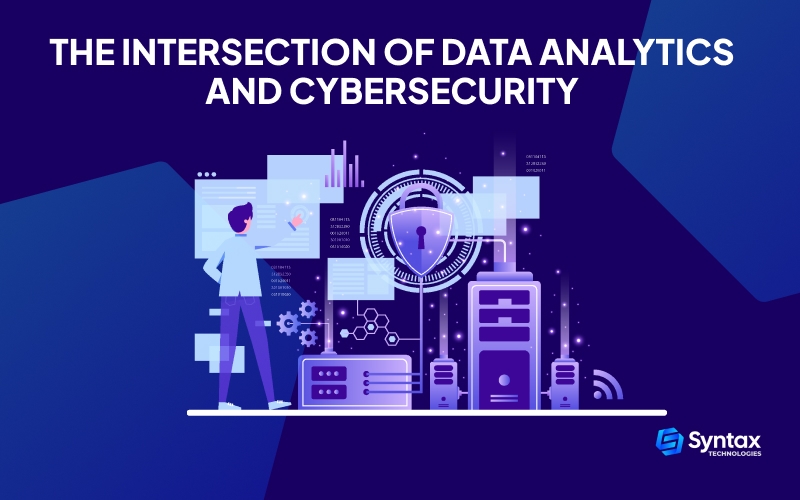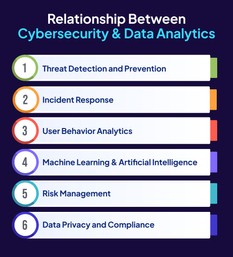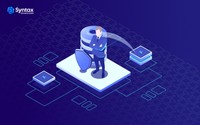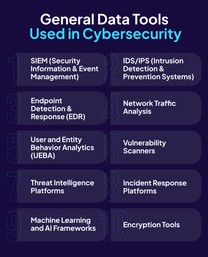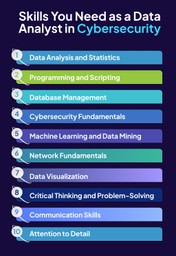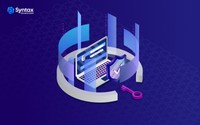Welcome, future data analysts, to the thrilling crossroads where the worlds of data science and cybersecurity converge in an area of innovation and impact!
And here’s the deal: data is like a treasure map for tech, and your job is to decode it.
But at the same time, you’re also the guardian, making sure no sneaky hackers mess with the good stuff.
With a data analytics course, you can brush up on your knowledge about important data analysis basics to help guide you before starting the exciting new journey ahead!
What is the Relationship Between Cybersecurity and Data Analytics?
The relationship between cybersecurity and data analytics is significant, as both fields play crucial roles in managing and securing digital information.
Here are several critical aspects of their relationship:
Threat Detection and Prevention
Data Analytics Role: Data analytics can be employed to identify patterns, anomalies, and trends in large datasets. By analyzing network traffic, system logs, and user behavior, data analytics can help in the early detection of cyber threats.
Cybersecurity Role: Cybersecurity professionals use the insights generated by data analytics to develop and implement adequate security measures. This may include updating intrusion detection systems, creating rules for firewall configurations, and establishing behavioral analytics for user monitoring.
Incident Response
Data Analytics Role: In the event of a security incident, data analytics can be used to investigate and understand the scope of the breach. It helps in forensics and understanding attackers’ tactics, techniques, and procedures (TTPs).
Cybersecurity Role: Cybersecurity teams leverage data analytics to respond quickly to incidents. They can make informed decisions to contain and remediate threats by analyzing real-time data.
User Behavior Analytics
Data Analytics Role: Analyzing user behavior can help create baseline models for expected behavior. Deviations from these patterns can signal potential security threats.
Cybersecurity Role: Understanding normal user behavior is crucial for identifying abnormal activities that may indicate a security incident. User behavior analytics (UBA) is critical to modern cybersecurity strategies.
Machine Learning and Artificial Intelligence
Data Analytics Role: Machine learning and artificial intelligence techniques are often used in data analytics to improve the accuracy and efficiency of threat detection.
Cybersecurity Role: These same techniques are employed in cybersecurity for tasks such as malware detection, anomaly detection, and predictive analysis to stay ahead of evolving threats.
Risk Management
Data Analytics Role: Data analytics helps assess and quantify risks by analyzing historical data and identifying potential vulnerabilities.
Cybersecurity Role: Cybersecurity professionals use risk assessments derived from data analytics to prioritize security measures and allocate resources effectively.
Data Privacy and Compliance
Data Analytics Role: Data analytics can assist organizations in ensuring compliance with data privacy regulations by monitoring and analyzing data access and usage.
Cybersecurity Role: Cybersecurity measures, including encryption and access controls, are crucial for protecting sensitive data and ensuring compliance with privacy regulations.
What is Big Data Analytics in Cybersecurity?
Big data analytics in cybersecurity involves the use of advanced analytical techniques to process, analyze, and derive meaningful insights from massive and complex datasets generated within the cybersecurity landscape.
The term “big data” refers to extremely large and diverse datasets that traditional data processing methods may struggle to handle efficiently.
In the context of cybersecurity, big data analytics aims to extract valuable information to enhance threat detection, incident response, and overall security posture.
Here are key aspects of big data analytics in cybersecurity:
Volume, Variety, and Velocity
- Volume: Cybersecurity generates vast amounts of data, including network traffic logs, system logs, user activities, and more. Big data analytics is designed to handle the sheer volume of this data.
- Variety: Cybersecurity data comes in various forms, such as structured data (databases), semi-structured data (logs), and unstructured data (text). Big data analytics can process and analyze diverse data types.
- Velocity: The speed at which data is generated in cybersecurity is crucial. Big data analytics tools can process and analyze data in near real-time, allowing for swift responses to security incidents.
Several big data tools are widely used in cybersecurity to process, analyze, and derive insights from massive datasets.
Here are some examples:
- Apache Hadoop
- Use Case: Distributed storage and processing of large datasets.
- How It’s Used: Hadoop’s Distributed File System (HDFS) allows for the storage of vast amounts of data, and its MapReduce programming model enables distributed processing.
- Apache Spark
- Use Case: In-memory data processing and analytics.
- How It’s Used: Spark provides a fast and general-purpose cluster computing framework. It’s commonly used for processing large-scale data sets quickly and efficiently.
- ELK Stack (Elasticsearch, Logstash, Kibana)
- Use Case: Log management, searching, and visualization.
- How It’s Used: Elasticsearch is a search and analytics engine, Logstash is used for log data processing, and Kibana provides a visualization interface. Together, they form a powerful toolset for log analysis.
- Splunk
- Use Case: Log management, monitoring, and analysis.
- How It’s Used: Splunk is a platform that allows organizations to search, monitor, and analyze machine-generated data, making it valuable for security information and event management (SIEM).
- Apache Flink
- Use Case: Stream processing and analytics.
- How It’s Used: Flink is designed for real-time stream processing. It’s used to analyze and respond to data in motion, making it suitable for applications like threat detection in real-time.
- Apache Kafka
- Use Case: Distributed streaming platform.
- How It’s Used: Kafka is widely used for building real-time data pipelines and streaming applications. It facilitates the collection and processing of streaming data, which is crucial for cybersecurity use cases.
- TensorFlow
- Use Case: Machine learning and deep learning.
- How It’s Used: TensorFlow is an open-source machine learning framework. In cybersecurity, it can be applied to tasks like anomaly detection, malware classification, and predictive analytics.
- Apache Metron
- Use Case: Real-time security event processing and analytics.
- How It’s Used: Metron is designed for real-time big data security analytics. It includes capabilities for threat intelligence integration, behavior analytics, and rapid incident response.
- ArcSight (Micro Focus)
- Use Case: Security information and event management (SIEM).
- How It’s Used: ArcSight is an SIEM solution that helps organizations collect, analyze, and respond to security events. It plays a crucial role in identifying and mitigating security threats.
- Snort
- Use Case: Intrusion detection and prevention.
- How It’s Used: Snort is an open-source network intrusion detection and prevention system (IDS/IPS). It analyzes network traffic and detects potential security threats based on predefined rules.
These tools form the backbone of big data analytics in cybersecurity, enabling organizations to process and analyze large volumes of data to identify and respond to security threats effectively.
Depending on specific use cases and requirements, organizations may leverage one or more of these tools in their cybersecurity operations.
What Kind of General Data Tools are Used in Cybersecurity?
Data analysts eyeing a move to cybersecurity, listen up.
In this field, it’s not about making friends; it’s about securing data with no room for error.
Here are some no-nonsense tools you need to get familiar with:
- SIEM (Security Information and Event Management)
- Why you need it: SIEM tools are your data command post. They collect and analyze security data in real-time. Check out Splunk, Elastic Security, and IBM QRadar.
- IDS/IPS (Intrusion Detection and Prevention Systems)
- Why you need it: These are your cyber watchdogs. IDS tools detect, IPS tools prevent. Snort and Suricata are solid options.
- Endpoint Detection and Response (EDR)
- Why you need it: EDR tools keep an eye on individual devices, acting like personal detectives for security incidents. CrowdStrike and Carbon Black are players in this game.
- Network Traffic Analysis
- Why you need it: Monitor and analyze network traffic for unusual patterns. Zeek (formerly Bro) is an open-source option to consider.
- User and Entity Behavior Analytics (UEBA)
- Why you need it: UEBA tools are your behavior detectives, sniffing out deviations from normal user actions. Forcepoint and Exabeam are in the ring.
- Vulnerability Scanners
- Why you need it: Scan your fortress for weak spots. Nessus and OpenVAS do the job efficiently.
- Threat Intelligence Platforms
- Why you need it: Stay ahead of threats with intel platforms. ThreatConnect and Anomali keep you in the loop.
- Incident Response Platforms
- Why you need it: When the going gets tough, you need a response plan. Demisto (Palo Alto Networks) is your go-to for managing incidents.
- Machine Learning and AI Frameworks
- Why you need it: These are the brains of the operation. TensorFlow and PyTorch enhance threat detection with machine learning and AI.
- Encryption Tools
- Why you need it: Lock down your data with encryption tools. VeraCrypt and OpenSSL get the job done.
You’re not here to make friends; you’re here to lock down and defend.
So, get to know these tools, analyze the data, and secure those digital walls.
Is College
Worth It Anymore?
What Kind of Skills and Certifications Do You Need as a Data Analyst in Cybersecurity?
To work as a data analyst in cybersecurity, you need a mix of technical and analytical skills, along with relevant analytics certifications to validate your expertise.
Here’s a breakdown of the key skills and certifications you should consider:
Skills
Data Analysis and Statistics
Proficiency in statistical analysis, data interpretation, and deriving insights from large datasets.
Programming and Scripting
Knowledge of programming languages like Python, R, or scripting languages like Bash.
Database Management
Understanding of relational databases (e.g., SQL) and experience in managing and querying databases.
Cybersecurity Fundamentals
Understanding of cybersecurity principles, common threats, vulnerabilities, and attack vectors.
Machine Learning and Data Mining
Familiarity with machine learning algorithms, techniques for classification, clustering, and data mining.
Network Fundamentals
Understanding of network protocols, traffic analysis, and network security concepts.
Data Visualization
Proficiency in tools like Tableau, Power BI, or matplotlib for creating meaningful visualizations.
Critical Thinking and Problem-Solving
The ability to analyze difficult problems, think critically, and develop effective solutions.
Communication Skills
Clear and effective communication of findings and insights to both technical and non-technical audiences.
Attention to Detail
Thorough examination of data, recognizing patterns, and identifying anomalies.
Certifications
Certified Information Systems Security Professional (CISSP)
- Description: Recognized industry-wide, CISSP covers various domains, including security and risk management.
- Relevance: Essential for professionals seeking a broad understanding of cybersecurity principles and practices.
Certified Ethical Hacker (CEH)
- Description: Focuses on ethical hacking skills, providing knowledge about vulnerabilities and potential threats.
- Relevance: Ideal for those interested in understanding the mindset and techniques of hackers for defensive purposes.
CompTIA Security+
- Description: Entry-level certification covering foundational cybersecurity skills.
- Relevance: Suitable for beginners looking to establish a baseline in cybersecurity concepts.
GIAC Certified Incident Handler (GCIH)
- Description: Concentrates on incident handling, response, and analysis.
- Relevance: Valuable for professionals involved in incident response and cybersecurity operations.
Certified Information Security Manager (CISM)
- Description: Emphasizes management-oriented skills in information security governance and risk management.
- Relevance: Suitable for those aspiring to take on managerial roles in cybersecurity.
AWS Certified Big Data – Specialty
- Description: Validates skills in using AWS for big data solutions.
- Relevance: Ideal for data analysts working with big data on the Amazon Web Services platform.
Microsoft Certified: Azure Data Scientist Associate
- Description: Focuses on using Azure for data science tasks.
- Relevance: Relevant for data analysts working with big data solutions on the Microsoft Azure cloud platform.
Certified Analytics Professional (CAP)
- Description: General analytics certification covering the end-to-end analytics process.
- Relevance: Suitable for professionals seeking a broader certification in analytics, applicable in various domains.
Certifications play a crucial role in validating your expertise and knowledge in very specific areas of cybersecurity and data analytics.
Career Transition Toolkit
The Synergy of Cybersecurity and Data Analytics with Syntax Technologies
As we conclude our exploration into the powerful synergy of cybersecurity and data analytics, it’s clear that this dynamic partnership is not just a theoretical concept but a practical necessity in our increasingly digitized world.
For those eager to dive into the exciting realm where cybersecurity meets data analytics, Syntax Technologies stands as a beacon of guidance.
Offering a comprehensive course covering business intelligence, Tableau, and other crucial tools, Syntax Technologies provides a roadmap for enthusiasts and professionals alike.
Let Syntax Technologies guide your learning journey in cybersecurity and data analytics. Prepare for future challenges and opportunities with our trusted expertise.
